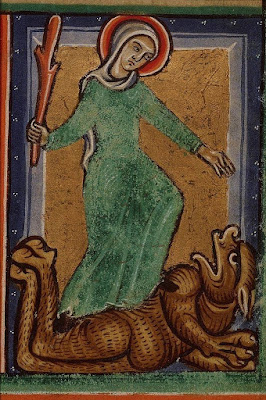4 romance and hagiography
Section outline
-
-
The Liflade and te Passiun of Seinte Juliene is one of the three lives of Virgin Martyr saints (the other two being St Katherine of Alexandria and St Margaret) included in a collection of texts relating the virtues and advantages of virginity as a "career option" for women (the so-called Katherine Group). Scholars have associated the collection with other manuscripts and works concerned with female spirituality in general, and anachoritic life in particular - the so-called Wooing Group and most famous of them all, the Ancrene Wisse (Guide for Anchoresses). The manuscript dates to the first quarter of the 13th century, the texts were probably composed around the year 1200 in the area of the Welsh-English border.
The individual texts postulate a range of reception contexts but, as the Ancrene Wisse, they seem to be primarily addressed to women of some social standing, contemplating a religious career. Such readers might well read texts in English and French but not in Latin.
As you will note, the text develops the Old English alliterative tradition, looking back to earlier native models; at the same time, it works with images of love from the courtly lyric and romance tradition well before the first attested specimens of those genres in English.
forum: I'd like to ask you to compare the Liflade version of the narrative of Juliana's life and martyrdom with the Latin source and try to describe the additions and modifications that it introduces, and how they change your perception of the issues foregrounded in each of the two texts.
session: If, as seems likely, the Life engages in a dialogue with romance narrative patterns and motifs, to what end(s) does it use them? Is it more like a general "reshaping" or a strategic application in specific key situations?
-
